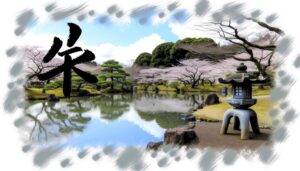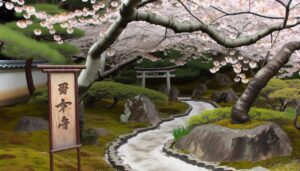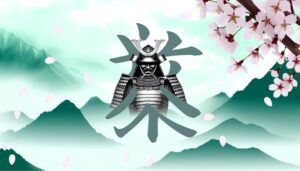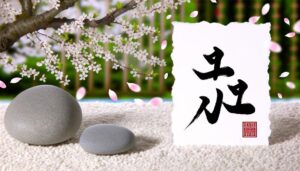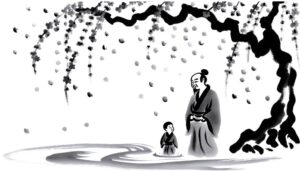How to Use Japanese Symbols to Ward Off Evil
To ward off evil, Japanese culture employs various symbols deeply rooted in religious and spiritual practices. Omamori charms, available at Shinto and Buddhist temples, are widely used for protection.
Ofuda talismans, inscribed with prayers or deities' names, are placed in homes or businesses for divine safeguarding. Shimenawa ropes, made from rice straw, demarcate sacred spaces and purify against malevolent spirits.
Additionally, Torii gates delineate sacred from secular, while Komainu statues at shrine entrances symbolize protection. Each of these items reflects Japan's intricate blend of Shinto and Buddhist traditions, inviting further exploration into their cultural significance.

Key Takeaways
- Omamori charms: Talismans for protection against evil, commonly purchased at temples and shrines.
- Ofuda talismans: Shinto objects inscribed with prayers to protect against malevolent forces.
- Shimenawa ropes: Demarcate sacred spaces and ward off evil spirits with symbolic purity.
- Komainu statues: Stone guardians placed at sacred sites to protect from malevolent forces.
- Hannya masks: Represent vengeful spirits to ward off evil and embody the duality of human emotion.
Omamori Charms
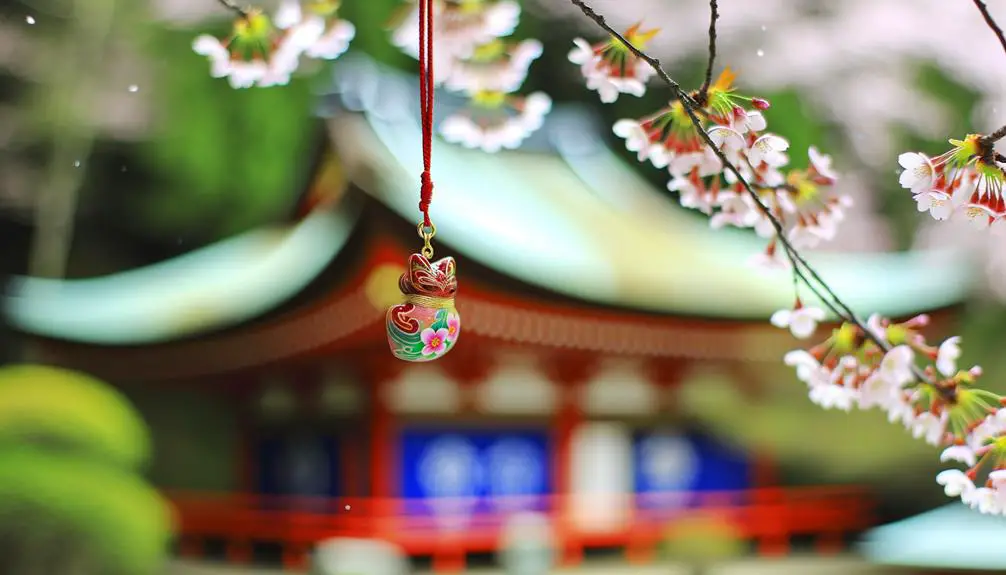
Omamori charms, frequently seen hanging in homes, cars, and even on personal belongings in Japan, serve both as talismans for protection and as significant cultural artifacts that reflect the intricate interplay between Shinto and Buddhist traditions.
These small, often elaborately designed amulets are believed to provide various forms of spiritual safeguarding, such as health, success, and safety, depending on their specific inscriptions. Their origins trace back to ancient practices where objects were imbued with divine spirits or 'kami' to offer blessings or ward off malevolent forces.
Today, they are commonly purchased at temples and shrines, encapsulating a blend of religious beliefs and cultural practices. The continued reverence for Omamori underscores Japan's enduring connection to its spiritual heritage.
Daruma Dolls
Daruma dolls have a fascinating origin linked to the Buddhist monk Bodhidharma. They are designed to embody a rich historical tradition that aims to foster perseverance and ward off misfortune. These hollow, round Japanese dolls carry deep symbolism, often representing the virtues of resilience and good luck.
Understanding the historical context, symbolic significance, and practical application of Daruma dolls provides a detailed view of how they serve as powerful talismans in Japanese culture.
Origin and History
Rooted in the rich tapestry of Japanese folklore and Buddhist tradition, the iconic Daruma doll embodies a centuries-old symbol of perseverance and good fortune.
Emerging during the Edo period (1603-1868), these hollow, round dolls were inspired by Bodhidharma, the founder of Zen Buddhism. Daruma's legendary nine-year meditation, during which he purportedly lost the use of his limbs, is reflected in the doll's limbless, resilient design.
Crafted traditionally from papier-mâché, the Daruma's form is intentionally unstable, designed to right itself when tipped over, symbolizing the Japanese proverb 'nanakorobi yaoki' (seven times down, eight times up).
This ethnographic artifact encapsulates the cultural ethos of tenacity and spiritual fortitude, serving as a historical touchstone within Japanese society.
Symbolism and Meaning
Often regarded as more than mere decorative objects, Daruma dolls encapsulate profound layers of symbolism and meaning deeply ingrained in Japanese cultural and spiritual practices. The design, often modeled after Bodhidharma, signifies resilience and perseverance.
Key symbolic elements include:
- Eyes: Initially blank, eyes are painted to set and achieve goals.
- Rounded Shape: Represents the ability to 'fall seven times, stand up eight,' symbolizing persistence.
- Color: Traditionally red, associated with warding off evil spirits and offering protection.
- Facial Hair: Mimics the crane and tortoise, symbols of longevity and good fortune.
This ethnographic artifact serves not only as a cultural emblem but also as a motivational tool, embodying the ethos of resilience and continuous self-improvement.
How to Use
To incorporate Daruma dolls into personal or communal practices effectively, one must understand the nuanced and ritualistic steps that honor their cultural significance and guarantee their intended purpose is fulfilled. Initially, one paints a single eye while making a specific wish or goal. This act embodies commitment and focuses intent. Upon achieving the goal, the second eye is painted to symbolize fulfillment and gratitude.
| Step | Action |
|---|---|
| Initial Setup | Paint one eye while making a wish |
| Daily Reminder | Place the doll in a visible, respectful spot |
| Goal Fulfillment | Paint the second eye in appreciation |
This practice not only serves as a motivational tool but also as a cultural homage, reinforcing the interconnectedness between intention and action within Japanese tradition.
Maneki-Neko
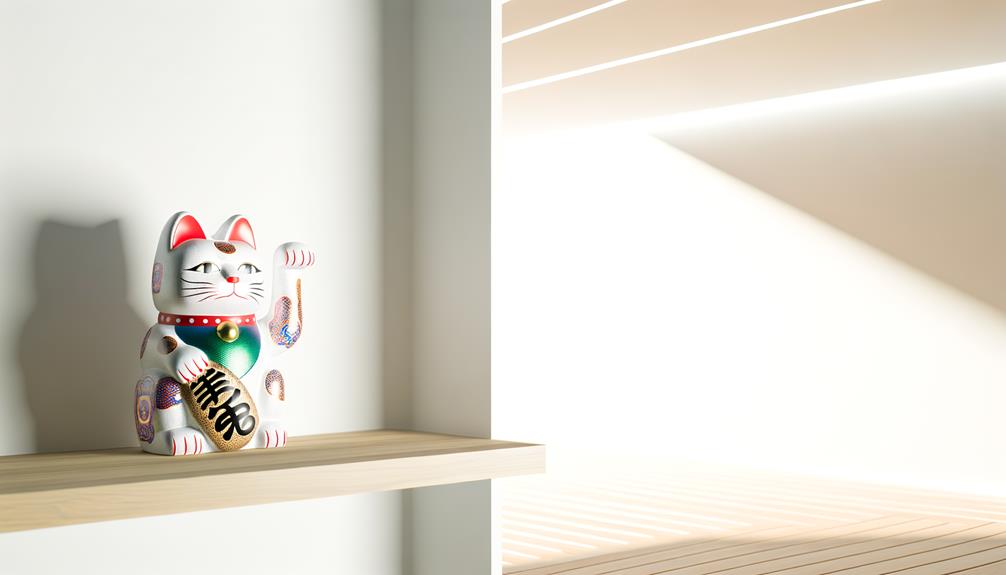
Maneki-Neko, the beckoning cat figurine ubiquitous in Japanese culture, serves as both a talisman to attract good fortune and a symbol believed to ward off malevolent spirits. Traditionally placed at the entrance of homes and businesses, its origins trace back to the Edo period, embodying a complex blend of folklore and superstition.
The raised paw is particularly significant, with the left paw inviting customers and the right paw ushering in wealth. The Maneki-Neko's colors also hold symbolic meanings, adding layers of cultural nuance.
- Left Paw Raised: Attracts customers or people.
- Right Paw Raised: Brings wealth and prosperity.
- Color Variations: White symbolizes purity, black wards off evil spirits, and gold attracts wealth.
- Placement: Commonly found in businesses, homes, and temples.
This figurine's multifaceted symbolism enriches its role in Japanese spiritual and commercial practices.
Ofuda Talismans
Ofuda talismans, deeply rooted in Shinto tradition, serve as powerful spiritual tools believed to offer protection, health, and purification to those who possess them. These sacred paper or wooden plaques, inscribed with the names of deities or specific prayers, are typically consecrated at Shinto shrines.
Ofuda are often placed in homes, businesses, or even carried on one's person to guarantee divine safeguarding against malevolent forces. Ethnographically, their significance extends beyond mere superstition; they embody a tangible connection to Shinto deities and rituals, reflecting an intricate interplay between spirituality and daily life.
The practice of renewing Ofuda annually underscores a communal reverence for continuity, purity, and spiritual well-being, reinforcing their role as essential elements in Japanese cultural and religious practices.
Shimenawa Ropes
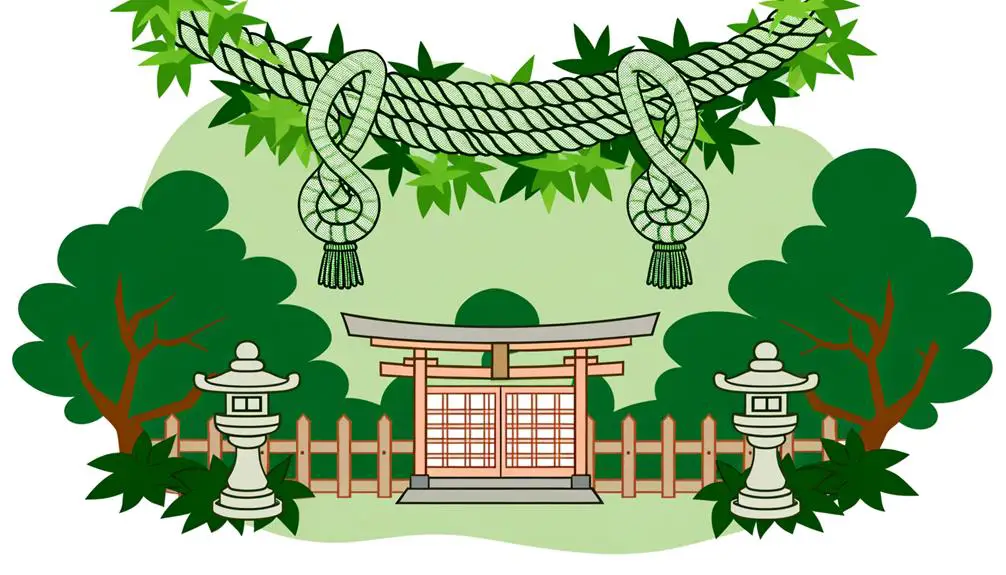
Shimenawa ropes, with their origins steeped in Shinto traditions, have historically been employed to demarcate sacred spaces and ward off malevolent spirits.
Typically crafted from rice straw or hemp, their material composition is not merely functional but symbolically rich, embodying purity and protection.
In contemporary Japan, these ropes persist in usage during various rituals and ceremonies, reflecting an enduring cultural reverence for their protective qualities.
Historical Significance
Historically, the intricate craftsmanship and cultural significance of shimenawa ropes have played a pivotal role in Japanese rituals and spiritual practices. These sacred ropes, typically found at Shinto shrines, demarcate the boundary between the secular and the divine. Their relevance extends beyond mere decoration; they are imbued with deep symbolism and historical resonance.
- Ancient Origins: Shimenawa ropes have been used since the Nara period (710-794 AD) to ward off evil spirits.
- Ceremonial Usage: They are prominently featured in Shinto ceremonies, marking sacred spaces.
- Symbolic Barriers: Acting as a protective barrier, they signify purity and the presence of kami (deities).
- Cultural Continuity: The use of shimenawa ropes remains a living tradition, reflecting Japan's enduring spiritual heritage.
Material Composition
The material composition of shimenawa ropes, traditionally crafted from rice straw or hemp, is meticulously chosen for its symbolic purity and strength, reflecting the deep-seated cultural values inherent in Shinto spirituality. This choice of materials is not arbitrary but is deeply rooted in ethnographic traditions that underscore the sacredness of the natural world. The following table outlines key attributes associated with these materials:
| Material | Symbolic Significance |
|---|---|
| Rice Straw | Purity, Abundance |
| Hemp | Strength, Resilience |
| Combined Use | Balance, Harmony |
These materials are woven with great care, ensuring that each shimenawa is not merely a physical object but a conduit of spiritual protection. This careful selection and craftsmanship serve to reinforce the cultural ethos of sanctity and reverence for nature.
Modern Usage
In contemporary Japan, the utilization of shimenawa ropes extends beyond traditional Shinto shrines, finding relevance in various modern settings as symbols of protection and cultural heritage. These sacred ropes, typically made from rice straw or hemp, are now seen adorning homes, businesses, and public spaces. Their presence signifies a barrier against malevolent forces and a marker of sanctity. This modern adaptation reflects both a reverence for cultural traditions and an enduring belief in their protective power.
Residential Entrances: Used to safeguard homes from negative energies.
Commercial Establishments: Displayed to attract prosperity and ward off misfortune.
Public Events: Employed in ceremonies and festivals to maintain spiritual purity.
Art Installations: Incorporated into contemporary art to blend traditional symbolism with modern aesthetics.
This multifaceted usage underscores the shimenawa's ongoing cultural significance.
Torii Gates
Torii gates, often seen at the entrances of Shinto shrines, serve as significant cultural symbols delineating sacred spaces from the secular world. These structures, typically made of wood or stone, mark the threshold where mundane existence gives way to the divine.
Their architectural simplicity—a horizontal bar supported by two vertical pillars—embodies a profound spiritual shift. Historically, torii gates are believed to ward off evil spirits, acting as protective barriers for the sanctified grounds they enclose.
Ethnographically, they are not mere architectural elements but carry deep cultural resonance, symbolizing purification and the demarcation of holy precincts. Therefore, torii gates play an essential role in Japanese religious practices and cultural heritage, inviting reverence and contemplation.
Komainu Statues

Often flanking the entrances of Shinto shrines, komainu statues serve as vigilant guardians, embodying a rich tapestry of cultural and religious symbolism designed to safeguard sacred spaces from malevolent forces. These lion-dog figures, typically carved from stone, are steeped in Shinto and Buddhist traditions, reflecting an amalgamation of ancient Asian influences.
Key elements include:
- A pair formation: One with an open mouth ('A') and one with a closed mouth ('Un'), symbolizing the beginning and end of all things.
- Regal posture: Representing strength and vigilance.
- Protective symbolism: Believed to ward off malevolent spirits and guarantee the sanctity of the shrine.
- Artistic variations: Styles differ across regions, showcasing local craftsmanship and interpretation.
These statues encapsulate the spiritual essence of Shinto protective icons.
Hannya Masks
Hannya masks, deeply rooted in Japanese Noh theater, represent the tormented spirit of a woman transformed into a vengeful demon through intense jealousy and sorrow. These masks vividly capture the duality of human emotion, portraying both rage and sadness. The masks' intricate design, featuring sharp horns, piercing eyes, and a menacing mouth, serves to evoke fear and caution. The use of Hannya masks extends beyond theater, symbolizing the need to ward off evil and protect against malevolent spirits in various cultural contexts.
| Feature | Description |
|---|---|
| Horns | Symbolize demonic transformation |
| Piercing Eyes | Reflect intense anger and sorrow |
| Menacing Mouth | Evokes fear and serves as a warning |
Hannya masks remain a powerful emblem within Japanese cultural heritage, blending artistry with spiritual significance.
Conclusion
In examining symbols to ward off evil in Japanese culture, a diverse array of artifacts emerges, each with unique historical and cultural significance.
From Omamori charms to Hannya masks, these items serve as protective conduits within their respective contexts.
The anachronistic nature of these symbols, persisting through epochs, underscores their enduring relevance.
This ethnographic exploration reveals a profound societal investment in safeguarding against malevolent forces, highlighting a deep-seated cultural ethos of spiritual and physical protection.

